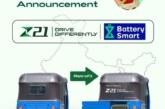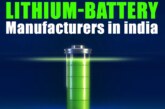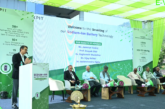
Electric vehicles new battery technologies
Electric vehicles batteries are a great concern since ages right from its invention by Professor Stratingh with his small electric car in 1835 in the Dutch town of Groningen. The first electric vehicle was made by Thomas Davenport in the US in 1834 then a farmer called as Moses made a two-seater electric vehicles in 1847 but due to lack of availability of electric cells the manufacture of EVs were stoped. However, we exactly can’t say when are electric vehicles invented but we can surely say that electric vehicles are the future and at current it has become the most popular and greener technology that people are looking forward to adopting it. Here are some of the Electric vehicles new battery technologies.
Evs are eco-friendly, gives high speed, cost-effective and doesn’t contribute to air and noise pollution these unique features have grabbed the attention of the people. More than 100 years vehicles have run on gasoline engines but EVs are developing rapidly these days. Batteries are an important component in electric vehicles as the electric Motor runs using the power stored in the batteries.
Let us now read in detail about Electric vehicles new battery technologies.
Electric vehicles new battery technologies
For decades, the researchers have been looking for the elimination of expensive materials or finding alternatives. The elimination or alternate inexpensive materials findings and explorations will help the making of the batteries cost-effective.
Elimination of cobalt from a lithium-ion battery-Cobalt-free
The elimination of the cobalt from the high-energy batteries that power electronic devices, due to its high cost and the human rights ramifications of its mining.
The Cockrell School of Engineering at The University of Texas at Austin have cracked the code to a cobalt-free high energy lithium-ion battery, eliminating the cobalt and opening the door to reduce the costs of producing batteries while boosting performance in some ways.
India & Australia collaborated to produce cheaper lithium batteries
The new class of cathodes-the electrode in a battery where all the cobalt typically resides anchored by high nickel content. The cathode in their study is 89% nickel. Manganese and aluminium make up the other key elements. If the nickel is more in batteries the more energy can be stored and can increase the energy density which leads to longer battery life for a phone or greater range for an electric vehicle with each charge.
The increased energy leads to trade-offs like cycle life, the number of times a battery can be charged and discharged before it loses efficiency and can no longer be fully charged. Eliminating cobalt usually slows down the kinetic response of a battery and leads to lower rate capability how quickly the cathode can be charged or discharged.
The researchers have overcome the short cycle life and poor rate capability problems through finding an optimal combination of metals and ensuring an even distribution of their ions. Most cathodes for lithium-ion batteries use combinations of metal ions, such as nickel-manganese-cobalt (NMC) or nickel-cobalt-aluminium (NCA).
Cathodes will make half of the materials costs for the entire battery, with cobalt being the priciest element. At a price of approximately $28,500 per ton, it is more expensive than nickel, manganese and aluminium combined, and it makes up 10% to 30% of most lithium-ion battery cathodes.
Manthiram, Li and former postdoctoral researcher Evan Erickson worked with UT’s Office of Technology Commercialization to form a startup called TexPower to bring the technology to market.
New self-heating battery technology
Engineers at Penn State University has developed a New Self-heating Battery Technology that allows the battery cells to charge up to 80 per cent in just 10 minutes, without facing any of the current limitations of fast charging. Mainly, the drawbacks include battery capacity degradation due to the formation of lithium plating during fast charging and lowered lifespan due to the sustained heat levels.
The new battery technology enables the individual battery cells to be rapidly heated during charging by providing an external self-heating nickel foil and then cooled during discharge. The heat obtained during charging time helps to prevent lithium plating and with this rapid heating cycle which will last for 10 minutes, the ill effects have been minimized up to a greater extent.
The new technology keeps hold of its battery capacity during fast charging over 1,700 cycles. Whereas the current battery technology which showed degradation after 60 cycles during fast-charging. This technology also exhibited its ability to retain its charge capacity over 91 per cent through 2,500 charge cycles, which is roughly equal to 8 lakh km of driving distance.
Some of the challenges in bringing this self-heating battery technology to accomplishment could be in bringing the batteries up to temperature in varying environmental conditions. But the technology is in its early days yet.
However, the battery technology is able to absorb 400kW of energy, while most of the currently available fast chargers charge at between 40-50kW DC. Some new EVs like the Porsche Taycan can accept up to 270kW and new charging technology should see DC fast chargers provide up to 450kW of energy soon.
Bipolar battery technology
An Indian multinational conglomerate company, Amara Raja Batteries has partnered with Gridtential Energy for bipolar battery technology.
The Gridtential Energy is the inventor of the silicon joule bipolar battery technology which has dual benefits such as traditional lead-acid batteries performance and the life cycle of lithium-ion batteries.
Both the companies under this partnership will assemble and test reference batteries using Amara Raja’s active material and work on the improvements in their life cycle, energy density, efficiency, charging rates, and manufacturability.
The Gridtential will provide non-exclusive licenses for its silicon joule technology to the manufacturing partners to adopt the facilities to provide high-performance batteries such as 24V and 48V batteries for hybrid automotive, energy storage systems, home backup markets and low-speed electric vehicles.
The CEO of Gridtential Energy, John Barton, said “We believe that silicon joule advanced lead battery technology is a perfect fit for the Indian market, offering a high-performance, low-cost solution. We are excited by the opportunity to show that our advanced lead technology offers superior price-performance and confidence that this will prove to be a successful platform for Amara Raja.”
The technology lets the development of the highly effective advanced batteries by using the patented silicon joule bipolar technology which comes with much wider temperature range and 40% lighter in weight as compared to the conventional batteries.
Replace the graphite anodes currently used in EV batteries
In another case, the scientists have made an attempt to replace the graphite anodes currently used in EV batteries with lithium metal anodes. But when the lithium metal extends an EV’s driving range by 30-50%, it also shortens the battery’s useful life due to lithium dendrites ( small tree-like defects that form on the lithium anode after many charge and discharges).
If these dendrites make contact with the cathode they short circuit the cells in the battery. For many years it was believed that the hard or solid electrolytes such as those made from ceramics, would work best to prevent dendrites from working their way through the cell. But the problem with that approach is that it didn’t stop dendrites from forming or “nucleating” in the first place, like tiny cracks in a car windshield that usually spread.
India’s lithium-ion battery technology
For many years it was believed that the hard, solid electrolytes, such as those made from ceramics, would work best to prevent dendrites from working their way through the cell. But the problem with that approach, many found, is that it didn’t stop dendrites from forming or “nucleating” in the first place, like tiny cracks in a car windshield that eventually spread.
The Researchers at the Department of Energy’s Lawrence Berkeley National Laboratory (Berkeley Lab), in collaboration with Carnegie Mellon University, introduced a new class of soft, solid electrolytes made from both polymers and ceramics that suppress dendrites in that early nucleation stage, before they can propagate and cause the battery to fail.
This technology is an example of Berkeley Lab’s multidisciplinary collaborations where its users develop new ideas to assemble, characterize, and develop materials and devices for solid-state batteries. These new soft, solid-electrolytes was the use of soft polymers of intrinsic microporosity, or PIMs, whose pores were filled with nanosized ceramic particles.
Because the electrolyte remains a flexible, soft, solid material, battery manufacturers will be able to manufacture rolls of lithium foils with the electrolyte as a laminate between the anode and the battery separator. These lithium-electrode sub-assemblies, or LESAs, are attractive drop-in replacements for the conventional graphite anode, allowing battery manufacturers to use their existing assembly lines.
Ultra light-weight metal-air batteries
The State-run fossil fuel giant Indian Oil Corporation Ltd (Indian Oil) is also developing an aluminium air battery in collaboration with an Israeli company Phinergy. Recently it has taken a minority stake from the Israel based startup. It is all set to begin field trials with a couple of leading Indian original equipment manufacturers (OEM)s to test the technology’s performance in Indian conditions.
The company said that if the trials turn successful, it may also venture into battery production in the country. The lithium-ion batteries, metal-air batteries provide more range up to 600 km for electric vehicles. If we compare the other batteries, especially the lithium-ion batteries which are in the full demand in the market metal-air batteries such as aluminium air are cheaper due to the cathode source is abundant and the anode can be made using a low-cost metal such as Al, Zn and Fe.
The Phinergy is expert in aluminium-air (Al-Air) and zinc-air battery systems which can be used in electric mobility and stationary applications. The metal-air batteries use metals like aluminium as the of and air as the cathode with a liquid electrolyte. The metal-air batteries use metals like aluminium as the anode and air as the cathode with a liquid electrolyte.
Battery recycling market, opportunity & challenges in India-Alternate to lithium imports
An aluminium-based metal-air battery uses oxygen from the air and combines it with the metal to form the aluminium hydroxide which activates the electrolysis process and creates an electric current. These batteries are lighter and compact with high energy density.
The al-air batteries provide many advantages like higher range, energy density, safety, longer life-cycle when compare with others. Under their partnership, IndianOil and Phinergy intend to build a factory in India to manufacture Al-Air batteries for electric vehicles and stationary applications and develop eco-system for Al-Air technology.
If you are an EV manufacturer or EV Dealer or EV Supporter who want to share news related to electric vehicles on our website, please send an email to crm@electricvehicles.in
For the latest electric vehicles news, follow electricvehicles.in on Twitter, Instagram,Facebook and subscribe to our YouTube Channels English, Hindi, Telugu and Kannada







